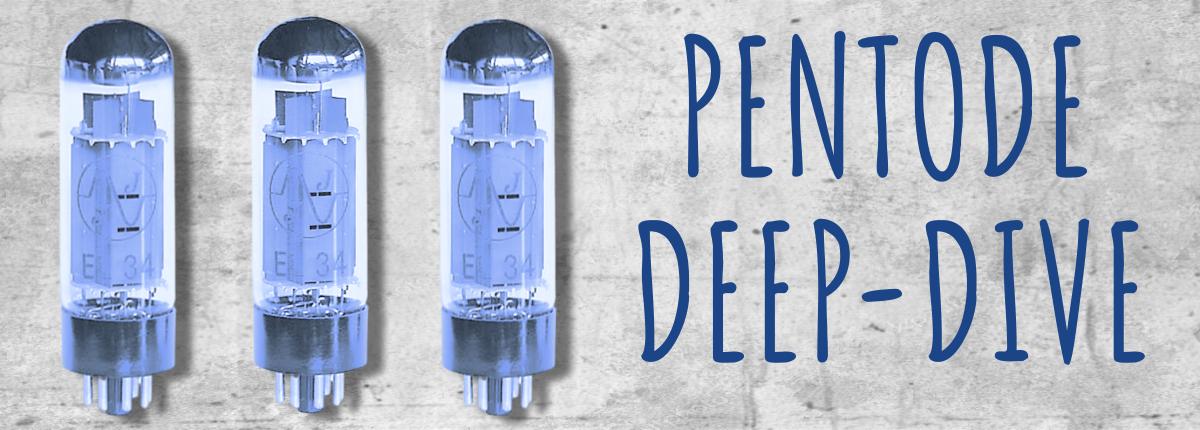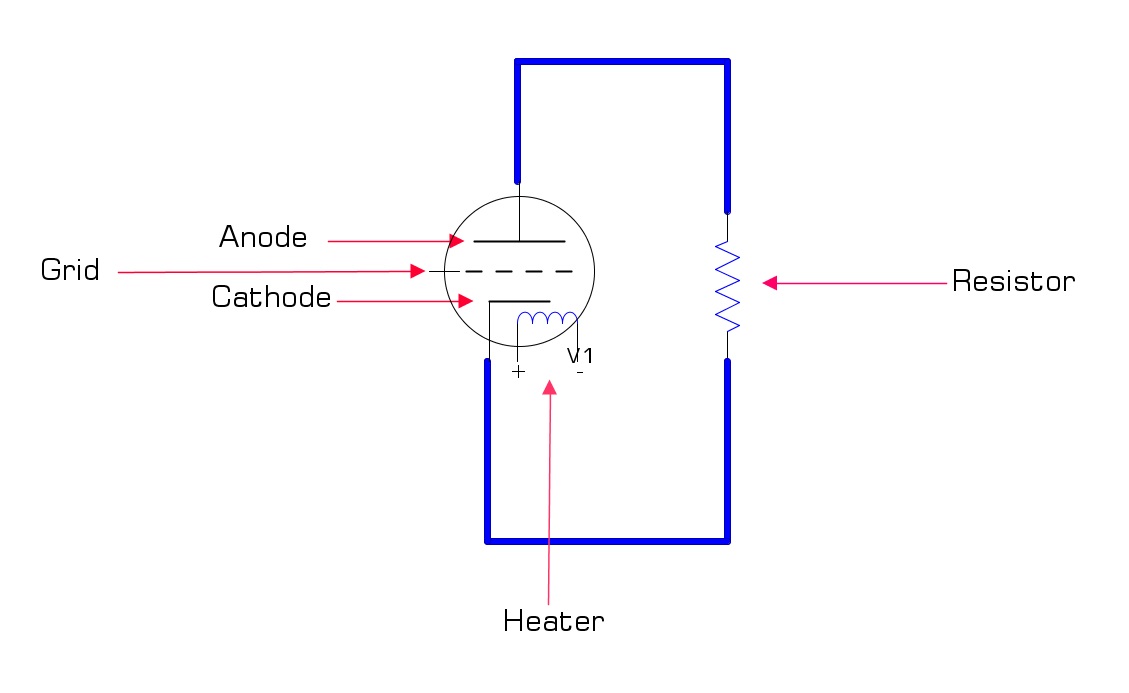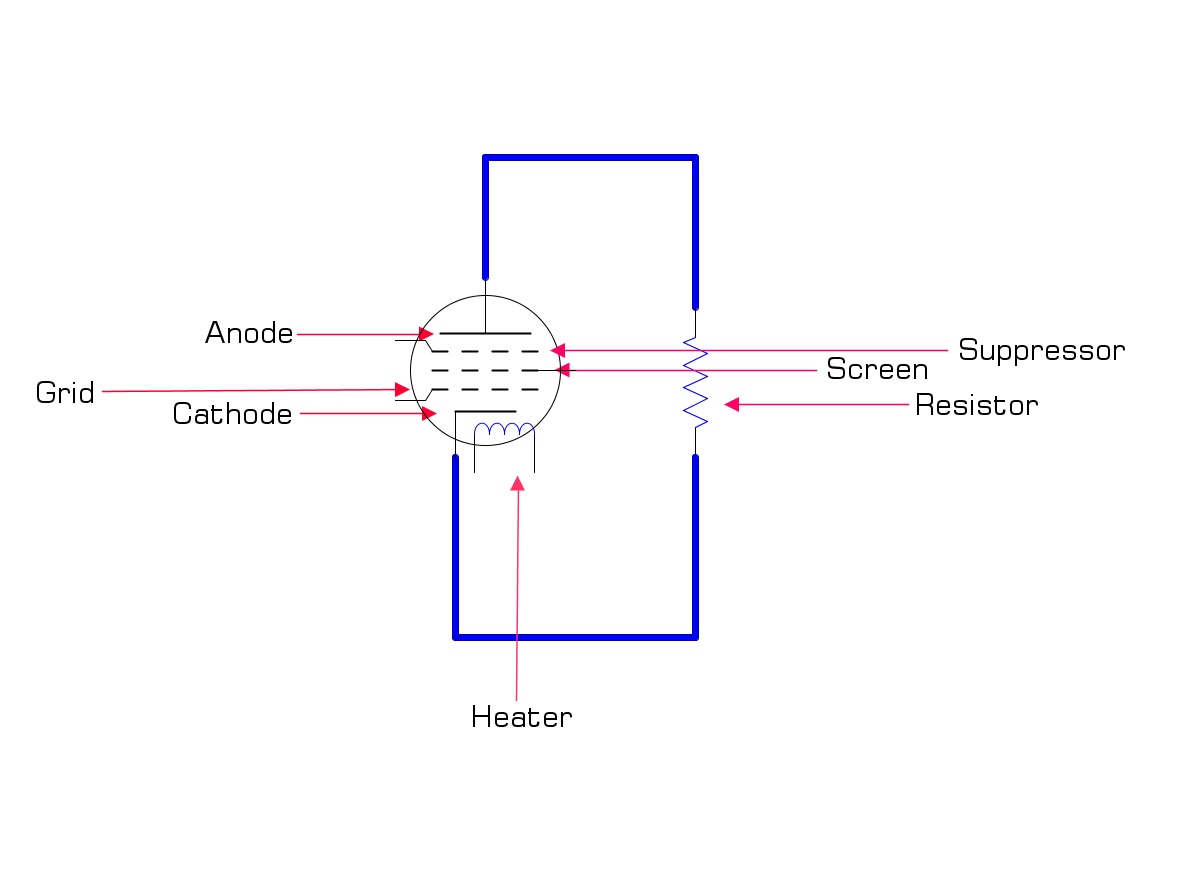
By Ed Malaker
Posted 02/22/2022
In this article, we’ll take a look at how a power amp tube works in your amplifier. We’ll also discuss several popular tubes and their differences, so you’ll know why you should use certain tubes rather than others and which ones you can substitute.
What Is a Power Tube?
Power tubes are electrical components in your amplifier responsible for amplifying your guitar signal to drive the large speakers that are often connected. We talked a lot about how the vacuum tube works, and the components inside these tubes, in our article titled How Does A Preamp Tube Work?, so we recommend reading that article first if you haven’t already. You may also want to refer to it if things are confusing or are moving too fast. We try to remember that we’re guitarists and not scientists, so we’ll keep it as simple as possible!
How Does It Work?
Triode
As we mention in the preamp tube article, most preamp tubes are triodes that use a cathode, anode, and grid to convert your guitar signal into an electrical current that your amp could use. A heater raises the temperature of the cathode until it begins to release electrons. These electrons move toward the anode and create a current. The higher the temperature of the cathode, the more current flows.
If you place a grid between the cathode and the anode, you can control the flow of electrons from the cathode to the anode by adjusting the voltage applied to the grid. Therefore, by applying your guitar signal to the grid, you can create a mirror image of it in the vacuum tube’s current.
Triode tubes work great for converting your guitar signal into something the amp can use, but as you continue to heat the cathode to release enough electrons to drive the eight 12-inch speakers in a Marshall Full-Stack, the simpler components in the triad tube cannot handle the large influx of electrons, and the tube begins to operate incorrectly. To get the power we require, we will need to move up to a pentode power tube.
Example 1 is an illustration of a triode tube.
Example 1
Pentode
The pentode tube has extra components within the vacuum tube that help it maintain control as the cathode temperature rises and more electrons get released. This added control maintains the integrity of the signal as the high current drives the speakers. We explained the extra components in How Does A Preamp Tube Work?, and we recommend checking it out if you need a refresher.
Example 2 is an illustration of the pentode tube.
Example 2
What Is Bias, and Do I Need to Adjust It?
Bias refers to the direct current going to the tubes, and you usually adjust it by using a multimeter and turning a variable potentiometer inside the amplifier until you reach the correct value. Each tube has a rating for how much current it should receive, and checking your amp for the plate current will tell you what you should set the Bias to. If you set the voltage too high, you will be running the tube hot, which can cause the sound to break up and distort before it should. It can also cause your tube to wear out faster. If you set the Bias too low, the amplifier can sound muddy and will not distort at all.
Most experts recommend Biasing the amplifier every time you install new tubes because the vacuum tube is an old component, and the specs can vary widely. Even two of the same model tube can be different. While modern technology is helping manufacturers build tubes more consistently, there is still a huge stockpile of unused vintage tubes leftover from our quick transition to the transistor and then finally to digital.
Biasing the amp is not hard once you’ve done it, but you must use extreme caution as a tube amplifier can give you a bad shock even when it’s turned off, and you must set the Bias with the amp turned on. Once you have set the Bias, you will need to play your guitar and listen to the sound closely. If the sound is too warm or you have a hard time getting it to break up into distortion, the Bias is set too low. If it distorts too easily, the Bias is set too high, and you will burn up your tubes much faster. If you are unsure how to Bias your amp properly or are afraid of electricity, it’s better to pay someone to do it for you.
Why Are There So Many Different Kinds of Power Tubes?
There are quite a few different types of power tubes, but most are just different versions of four main types: the EL84, EL34, 6L6, and the 6V6. We go over these tubes in great detail in Power Tube FAQ: EL84, EL34, and 6L6, and we recommend that you read It over to learn more about these important tubes. The primary difference between these is that they output different gains. They also use different materials or space the components slightly differently, which will have a slight but noticeable effect on your tone.
EL84s are the most modern and put out the highest gain. You will also find these tubes in many of the smaller amplifiers, and there are even a few effects pedals that make use of them. Though you can also find EL84s in larger amps, this territory is mostly dominated by the other tubes. The EL34 and the 6L6 are the most popular, and you can easily find them in many Fender, Marshall, Orange, and Peavey amplifiers, as well as many others.
Can I Replace EL34 Tubes With 6L6 Tubes?
Yes, in most cases, you should be able to swap out one type of tube for another, and this can be a great way to personalize your tone as each type will sound slightly different. You will need to adjust the biasing for each new tube, and we only recommend changing the tubes on all-tube amplifiers. You can potentially damage some of the new hybrid amplifiers if you send too much gain to the digital stage. We highly recommend checking the documentation or contacting the manufacturer before swapping out the tubes in a hybrid.
Other Tips
It may not be the best option, but if you’re afraid of electricity and can’t find someone to help with Biasing, you can often replace the worn tubes with the exact same make and model and get away without Biasing. Your amp will not sound as good as it could, and you might go through tubes more often, but you should get a usable tone most of the time.
Preamp tubes do not need you to set the Bias when you change them because they have a built-in mechanism that does it automatically. A few amplifiers will automatically set the Bias on the power tubes as well, but they are rare.
You can also swap out your preamp tubes for other types so you can explore new tonal possibilities.
Tubes wear out slowly, and it’s hard to notice the difference if you play every day, but you will notice a huge difference when you replace the tube. While your new tubes may indeed sound great, it’s important to remember that you are comparing them to old tubes.
Summary
Your power tube works very similarly to the preamp tubes that we discussed last time, but with a few modifications to help them manage the higher current they create, to accurately reproduce the guitar tone, and drive the speakers. Swapping out tubes can be a great way to make your tone unique to you, and after a few tries, you will be a master at setting Bias. When you’ve practiced enough, you will be able to hear when a tube is under or over Biased, and other guitar players will come to you to help set up their amp.
If you’ve found this article helpful, please feel free to share this with your friends on Facebook and Twitter. For more articles on guitar electronics, visit humbuckersoup.com.


